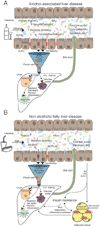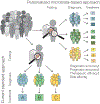Microbiota and Fatty Liver Disease-the Known, the Unknown, and the Future
- PMID: 32791115
- PMCID: PMC7467841
- DOI: 10.1016/j.chom.2020.07.007
Microbiota and Fatty Liver Disease-the Known, the Unknown, and the Future
Abstract
The liver communicates with the intestine via the portal vein, biliary system, and mediators in the circulation. Microbes in the intestine maintain liver homeostasis but can also serve as a source of pathogens and molecules that contribute to fatty liver diseases. We review changes in the gut microbiota that can promote development or progression of alcohol-associated and non-alcoholic fatty liver disease-the most common chronic liver diseases in Western countries. We discuss how microbes and their products contribute to liver disease pathogenesis, putative microbial biomarkers of disease, and potential treatment approaches based on manipulation of the gut microbiota. Increasing our understanding of interactions between the intestinal microbiome and liver might help us identify patients with specific disease subtypes and select specific microbiota-based therapies.
Keywords: ALD; NAFLD; NASH; alcohol use disorder; alcohol-associated liver disease; alcoholic hepatitis; metagenomics; microbiome; non-alcoholic fatty liver disease; non-alcoholic steatohepatitis.
Published by Elsevier Inc.
Conflict of interest statement
Declaration of Interests B.S. has been consulting for Ferring Research Institute, Intercept Pharmaceuticals, HOST Therabiomics, and Patara Pharmaceuticals. B.S.’s institution UC San Diego has received research support from BiomX, NGM Biopharmaceuticals, CymaBay Therapeutics, Synlogic Operating Company, and Axial Biotherapeutics. S.L. and B.S. have patents related to this work (PCT/US2019/024703 and US62/946,182).
Figures



References
-
- Allegretti JR, Kassam Z, Mullish BH, Chiang A, Carrellas M, Hurtado J, Marchesi JR, McDonald JAK, Pechlivanis A, Barker GF, et al. (2020). Effects of Fecal Microbiota Transplantation With Oral Capsules in Obese Patients. Clinical gastroenterology and hepatology : the official clinical practice journal of the American Gastroenterological Association. 18(4), 855–863.e852. - PubMed
-
- Arora T, and Bäckhed F (2016). The gut microbiota and metabolic disease: current understanding and future perspectives. J Intern Med. 280(4), 339–349. - PubMed
Publication types
MeSH terms
Grants and funding
LinkOut - more resources
Full Text Sources
Medical

